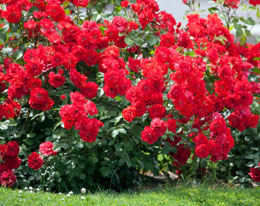Double knockout roses beautify every landscape in spring with their large, double-petaled blooms. Requiring less maintenance and resistant to common rose diseases, these improved knockout rose varieties are excellent performers for any type of soil. The following section gives more information about the same.

When it comes to disease and pest-resistant rose types, the single petaled knockout cultivar is the best. Another popular garden favorite is the newly developed hybrid called double knockout roses. They have all the positive attributes of the aforementioned rose type, and look more stunning with double petals. Perfect for any landscape design, they blend well with seasonal flowers, perennial blooms, and other bushes. You can also grow these plants in separate garden beds.
Growing Tips
Besides the spectacular flowers and a long blooming period, the popularity of double knockout roses is credited to other features like low maintenance and less disease infestations. It does not require deadheading even after the flowering period is over. These plants have replaced many landscaping shrubs in many gardens. They adapt well in USDA gardening zones 5-9.
Available in shades of pink and red, you can purchase healthy saplings of this plant from your local nursery center. Similar to other varieties of knockout roses, they grow best in moist, well-drained, slightly acidic (pH 5.6-6.8), and fertile soil. You need to prepare the soil in a sunny or partially shaded area to meet these requirements. You can also supplement organic fertilizer and farmyard compost to increase the water-holding capacity and provide sufficient nutrients to the plants.
After the last frost is over, make a hole that is twice the size of the actual root ball. Mix organic soil formulation and manure with the soil and add it in the hole. Make sure that the planting hole size matches the root ball. Place the plant in it and add soil to cover the root. Follow the same planting steps for the remaining rose plants, leaving a space of 3 feet between each. Deeply water them for quick establishment in the soil.
Tending Instructions
Roses are some of the most hardy ornamental plants. However, it does not mean that you plant them and leave them on their own for flowering. These hardy rose varieties require some care level for healthy growth and flowering. Rose pruning is done for removing dead and diseased branches, and controlling the shape and height of the plant. Given below are some guidelines on caring for double knockout roses.
Watering
With these varieties, the main tip is to keep the soil moist at all times. As the newly planted roses cannot tolerate dry spells, never let the soil dry out completely between two watering sessions. Instead of watering from an overhead position, irrigate the soil. Once the plants get established to the area, you can reduce the watering frequency.
Feeding
When grown in nutrient poor soil, supplementing the plants once a month with a slow release, organic rose fertilizer is suggested. If you do not have that much time, reduce the feeding frequency. These shrubs and bushes can tolerate nutrient deficiency to some extent, and will continue to bloom in the flowering period from spring to the arrival of the first frost.
Pruning
When allowed to grow naturally, these bushes grow about 3-4 feet high and 3 feet wide. Hence, regular trimming of the weak twigs, and one time pruning, are preferred for maintaining their spreading. During spring or after the last frost, pruning these flowers about 12-18 inches above the surface level is advisable for heavy bloom production.
Winter Care
Protection of these roses in winter is required when they are grown in very cold regions. Regarding winter care for roses, stop the feeding and allow the plants to remain in a dormant state. Preparation of these roses for cold winter frost involves planting them in a leeward direction, or making a mound with straw (about 12 inches wide and 12 inches tall) around the base of the main stem. You can remove this straw mound in spring.
Neither do these roses require special care like some other types, nor do they need deadheading every year. They are also resistant to powdery mildew, black spot, rust, and other rose diseases Thus, planting double knockout roses and is just as easy as growing any other hardy shrub in the garden.






 When it comes to disease and pest-resistant rose types, the single petaled knockout cultivar is the best. Another popular garden favorite is the newly developed hybrid called double knockout roses. They have all the positive attributes of the aforementioned rose type, and look more stunning with double petals. Perfect for any landscape design, they blend well with seasonal flowers, perennial blooms, and other bushes. You can also grow these plants in separate garden beds.
When it comes to disease and pest-resistant rose types, the single petaled knockout cultivar is the best. Another popular garden favorite is the newly developed hybrid called double knockout roses. They have all the positive attributes of the aforementioned rose type, and look more stunning with double petals. Perfect for any landscape design, they blend well with seasonal flowers, perennial blooms, and other bushes. You can also grow these plants in separate garden beds.